December 27, 2015: The Frink/Grigoriev study
By Frederic Friedel
Yesterday we told you how Garry Kasparov had given ten-year-old chess prodigy Vincent Keymer a study to solve, one that looked deceptively simple – just four pieces on the board, two of them pawns which can only move forward. How could that be so difficult?
The study is attributed to Nikolai Grigoriev, 1932, but as the ever-watchful Pal Benko pointed out yesterday, after we published the position: it is originally from the American composer Orrin Frink, whose study appeared in The Chess Amateur in 1927. It is the same as the one below, just reflected (wKc6, Ph2, bKd3, Pf7). However, Garry set up the Grigoriev version, so we will stick with that. The solution was thankfully annotated for us by Vincent.

[Event "Shakhmaty v SSSR#599"] [Site "?"] [Date "1932.08.30"] [Round "?"] [White "Grigoriev, Nikolai"] [Black "White to play and win"] [Result "1-0"] [Annotator "Keymer,Vincent"] [SetUp "1"] [FEN "8/2p5/6K1/8/8/5k2/P7/8 w - - 0 1"] [PlyCount "21"] [EventDate "1932.??.??"] 1. Kf5 $1 (1. Kf6 $2 Ke4 2. Ke6 Kd4 {ends in a draw.}) 1... Ke3 (1... c5 2. Ke5 Ke3 3. Kd5 Kd3 4. Kxc5 {wins for White.}) 2. Ke5 c6 {The only serious attempt to save the game for Black.} (2... c5 3. Kd5 Kd3 4. Kxc5 Kc3 5. a4 $18) (2... Kd3 3. Kd5 Kc3 (3... c6+ 4. Kc5 $1 Kc3 5. a4) 4. Kc5 {and Black quickly loses.} ) 3. a4 ({Not} 3. Kd6 $2 Kd4 4. Kxc6 Kc4 {with a draw.}) 3... Kd3 4. a5 c5 5. a6 c4 6. a7 c3 7. a8=Q c2 {This endgame appears to be a draw, but there is a beautiful idea which wins for White.} 8. Qd5+ $1 {The only winning move for White!} (8. Qe4+ $2 Kd2 9. Qd4+ Ke2 10. Qc3 (10. Qb2 Kd1 11. Qb3 Kd2 12. Qa2 Kc3) (10. Qe4+ Kd2 11. Qd5+ Ke1 $1) 10... Kd1 11. Qd3+ Kc1 12. Kd4 Kb2 13. Qe2 (13. Qd2 Ka1 $1) 13... Ka1 $1 (13... Kb1 $2 14. Kc3 c1=Q+ 15. Kb3) 14. Kc3 c1=Q+ 15. Kb3 Qb1+) (8. Qa1 $2 Kd2 9. Qa2 Kc3 $1 (9... Kd1 $2 10. Kd4 c1=Q 11. Kd3)) (8. Qa3+ $2 Kd2 9. Qa2 Kc3 $1) 8... Ke3 ({Or} 8... Ke2 9. Qa2 $1 Kd1 10. Kd4 c1=Q 11. Kd3 {with mate in three}) (8... Kc3 9. Qd4+ Kb3 10. Qa1 {wins for White.}) 9. Qg2 $3 {The main point I had to find.} Kd3 (9... c1=Q 10. Qg5+) 10. Qg5 $1 Kc3 11. Qc1 1-0

We showed you how Vincent handled the position in Garry's suite in the Berlin WestIn Hotel. At one stage he seemed stuck and I said to Garry: "Brain freeze? Maybe he's overawed by the situation of having to solve that in front of you? After all it's a fairly simple position – just four pieces..." – "No," said Garry, "it is absolutely non-trivial. You should try it on one of your 2600 or 2700 friends!"
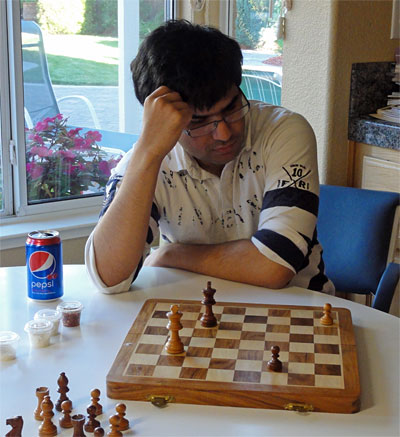
Which is what I did. The first victim was Parimarjan Negi, who became a full grandmaster at the age of 13 year 4 months and 22 days – the second youngest in history. Pari, who is currently rated 2664, is studying computer science in Berkley. On my recent trip to California we met and I gave him the study. It took him twelve minutes to solve, whereby he admitted that he was familiar with the endgame queen vs c-pawn.
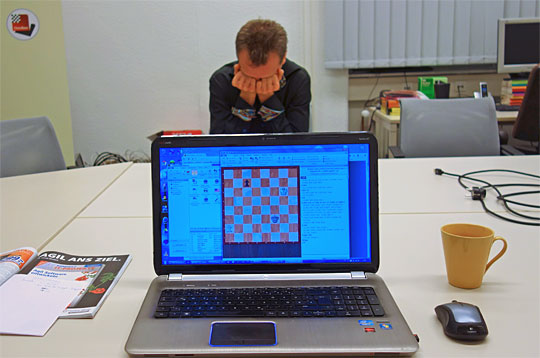
I also gave it to Uzbek GM Timur Gareev, one of the best blindfold simultaneous players in the world
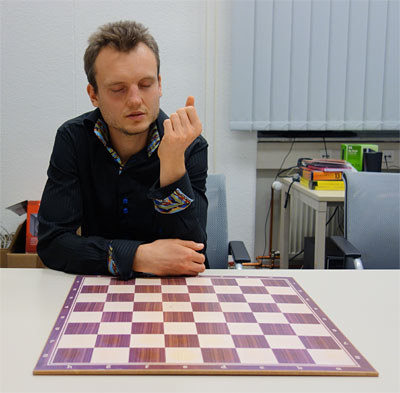
He needed 14 minutes to solve it – to find the key move 10.Qg2
The study reminded Timur of a game he had played in 2002, where the same ending occurred and his opponent had misplayed. Unfortunately the 14-year-old Timur had had not been able to find the draw.

[Event "RUS-Cup04"] [Site "Samara"] [Date "2002.07.27"] [Round "2"] [White "Popov, Valerij"] [Black "Gareev, Timur"] [Result "1-0"] [ECO "D37"] [WhiteElo "2579"] [BlackElo "2191"] [PlyCount "119"] [EventDate "2002.07.26"] [EventType "swiss"] [EventRounds "9"] [EventCountry "RUS"] [Source "ChessBase"] [SourceDate "2002.09.10"] 1. d4 d5 2. c4 e6 3. Nf3 Nf6 4. Nc3 Be7 5. Bf4 O-O 6. e3 Nbd7 7. Qc2 c5 8. O-O-O cxd4 9. Rxd4 Nb6 10. e4 Bc5 11. Rd1 Bb4 12. exd5 exd5 13. Nxd5 Nbxd5 14. cxd5 Bg4 15. Kb1 Rc8 16. Qb3 Bc5 17. Bd3 Kh8 18. Qxb7 Bxf2 19. h3 Bxf3 20. gxf3 Qxd5 21. Qxd5 Nxd5 22. Bd6 Rfd8 23. Bf5 Ne3 24. Bxc8 Nxd1 25. Rxd1 Rxc8 26. b4 Kg8 27. Rd2 Be3 28. Rc2 Rd8 29. Bc5 Bxc5 30. Rxc5 h6 31. Ra5 Rd7 32. a4 g5 33. Kc2 Kg7 34. Kc3 Kg6 35. Ra6+ f6 36. b5 h5 37. a5 h4 38. Kb4 Kf5 39. Rxa7 Rxa7 40. b6 Ra8 41. b7 Rb8 42. a6 Kf4 43. Kc5 Kg3 44. Kb6 Kxh3 45. a7 Rxb7+ 46. Kxb7 Kg3 47. a8=Q h3 48. Qh8 h2 49. Qh5 f5 50. Kc7 f4 51. Kd6 Kg2 52. Qxg5+ Kxf3 53. Qd5+ Ke3 54. Ke5 f3 55. Qd1 f2 {[#]} 56. Kd5 $2 {This move allows Black to draw!} (56. Kf5 {or Qf1 or Qh1 all win for White.}) 56... h1=Q+ 57. Qxh1 Ke2 58. Qh2 Ke1 $2 ({Black must play} 58... Kf3) 59. Ke4 Ke2 60. Qg2 1-0
An endgame lesson from Garry Kasparov
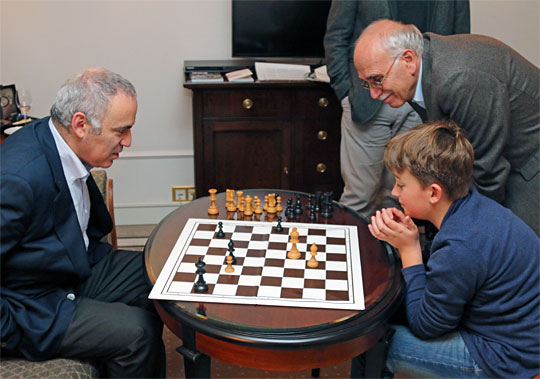
We now come to the next study that Garry gave Vincent. In the above picture
we have Erich Follath, a senior editor of the SPIEGEL news magazine, kibitzing.
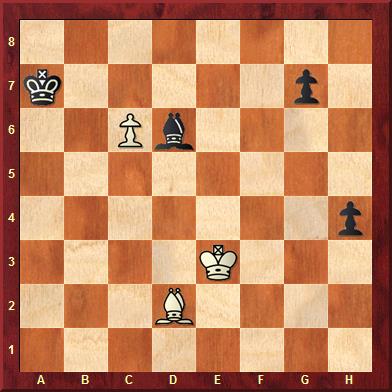
White to play and draw

Garry left Vincent to his own devices, to try and solve the study in his head...
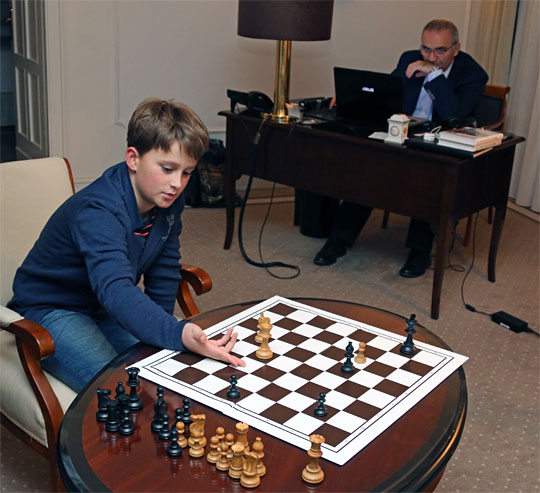
... while he attended to correspondence and watched from a distance.
A hint: it is a study where you have to choose between two moves, Kf2 and Kf3, as Vincent quickly recognized. There is no easy way to find the right move. What is needed is pure calculation!
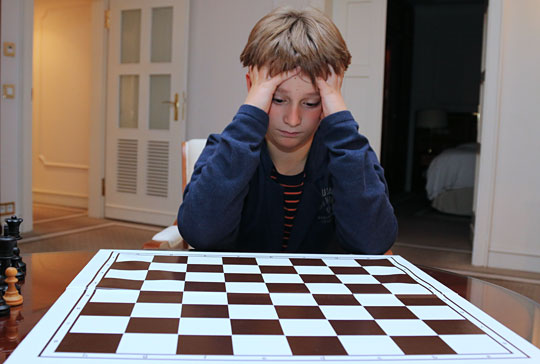
At one stage, when the boy was stuck, Garry offered some help: he swept the pieces
off the board and told Vincent to look for the solution entirely in his mind.
Well, we will leave you to study the position – and this time if you are stumped you are welcome to use a chess engine. Tomorrow we will give you the solution – in the form of a wonderful chess lesson, one which Vincent received from the World Champion.
Pal Benko's twins
This was the first mate-in-two problem yesterday:
Pal Benko, 2015

White to play and mate in two
We asked our readers to solve the problem and then construct a new position by moving a single piece to a different square. The new problem must again be a mate in two, with a different solution. And it must have no "cooks" – multiple solutions that will spoil an chess problem.
Three readers submitted what we consider proper twins (we have asked Pal Benko to confirm):
-
José Fernando Blanco of Spain proposed moving the pawn to g3 with the solution 1.Bb2 Ke3 2.Qe2#
-
IM Nisha Mohota wrote: "My creative brain immediately started making mate positions after seeing the problem! I propose moving the pawn from h2 to e2 and playing 1.Be3 Ke3 Qe5#. Later I found another twin: move the knight from g1 to d7 for 1.Ke2 Kd4 2.Qd3#."
-
Oh, yeah, and one Garry Kasparov suggested, by phone naturally, moving the pawn from h2 to h3, for 1.Ne2 Kf3 2.Qd5/c6/b7#.
The author's twin involves moving the pawn from h2 to c2:
Pal Benko, 2015
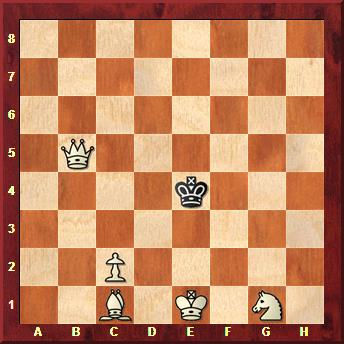
White to play and mate in two. Once again you are asked to solve this problem
and then find the next twin by moving a single piece to a different square.



































